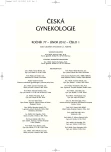Is the hysteroscopy the right choice for therapy of placental remnants?
Authors:
L. Hrazdírová; D. Kužel; Z. Žižka
Authors‘ workplace:
Gynekologicko-porodnická klinika VFN a 1. LF UK, Praha, přednosta prof. MUDr. A. Martan, DrSc.
Published in:
Ceska Gynekol 2012; 77(1): 35-38
Category:
Original Article
Overview
Objective:
The evaluation of the effectiveness and safety of hysteroscopic management of residual trophoblastic tissue and to verify the miniinvasivity with the second-look hysteroscopy.
Design:
Prospective study.
Setting:
Department of Gynecology and Obstetrics, First Faculty od Medicine, Charles University and General Teaching Hospital, Prague.
Methodology:
From 11/2007 to 6/2011, 58 patiens with abnormal uterine bleeding longer than 6 weeks after delivery or abortion underwent ultrasound examination with fading of hyperechogenic content larger than 15mm in AP projection. There was the bipolar resectoscopic system used under general anestesia. Second-look office hysteroscopy was recommended to all patiens 4–6 weeks after a primary procedure.
Results:
Median operative time was 15 (7–36) minutes, median time of hospitalisation was 7.1 hours. In four patients was necessary to divide the procedure into two phases (after 14 days). There was no serious uterine bleeding or inflamation in our study group. Only one serious surgical complication was registered: an uterine perforation in patient after 2 cesarean sections, there was the laparoscopic suture provided. The second-look hysteroscopy was provided in 45 patients (77.6%). There was normal intrauterine finding in 16 (35.6%) patients, in 29 patients (64.4%) a small residual trophoblastic tissue was resected. There was no secondary intrauterine adhesive process described.
Conclusion:
Hysteroscopic resection is a safe and efficient operative technique, which is suitable for management of larger trophoblastic tissue left after delivery or abortion.
Key words:
hysteroscopy, residual trophoblastic tissue, Asherman’s syndrome, intrauterine adhesions.
Sources
1. Abbasi, S., Jamal, A., Eslamian, L., et al. Role of clinical and ultrasound findings in the diagnosis of retained products of conception. Ultrasound Obstet Gynecol, 2008, 32, 5, p. 704-707.
2. Alcazar, JL. Transvaginal ultrasonography combined with color velocity imaging and pulsed Doppler to detect residual trophoblastic tissue. Ultrasound Obstet Gynecol, 1998, 11, 1, p. 54-58.
3. Ben-Ami, I., Schneider, D., Maymon, R., et al. Sonographic versus clinical evaluation as predictors of residual trophoblastic tissue. Hum Reprod, 2005, 20, 4, p. 1107-1111.
4. Deans, R., Dietz, HP. Ultrasound of the post-partum uterus. Aust N Z J Obstet Gynaecol, 2006, 46, 4, p. 345-349.
5. Durfee, SM., Frates, MC., Luong, A., et al. The sonographic and color Doppler features of retained products of conception. J Ultrasound Med, 2005, 24, 9, p. 1181-1186; quiz 1188-1189.
6. Edwards, A., Ellwood, DA. Ultrasonographic evaluation of the postpartum uterus. Ultrasound Obstet Gynecol, 2000, 16, 7, p. 640-643.
7. Faivre, E., Deffieux, X., Mrazguia, C., et al. Hysteroscopic management of residual trophoblastic tissue and reproductive outcome: a pilot study. J Minim Invasive Gynecol, 2009, 16, 4, p. 487-490.
8. Fernandez, H., Al-Najjar, F., Chauveaud-Lambling, A., et al. Fertility after treatment of Asherman’s syndrome stage 3 and 4. J Minim Invasive Gynecol. 2006, 13, 5, p. 398-402.
9. Jimenez, JS., Gonzalez, C., Alvarez, C., et al. Conservative management of retained trophoblastic tissue and placental polyp with diagnostic ambulatory hysteroscopy. Eur J Obstet Gynecol Reprod Biol, 2009, 145, 1, p. 89-92.
10. Kuzel, D., Horak, P., Hrazdirova, L., et al. „See and treat“ hysteroscopy after missed abortion. Minim Invasive Ther Allied Technol, 2011, 20, 1, p. 14-17.
11. Kuzel, D., Toth, D., Hrazdirova, L., et al. [„See and treat“ hysteroscopy: limits of intrauterine pathology bulk]. Ces Gynek, 2006, 71, 4, p. 325-328.
12. Maslovitz, S., Almog, B., Mimouni, GS., et al. Accuracy of diagnosis of retained products of conception after dilation and evacuation. J Ultrasound Med, 2004, 23, 6, p. 749-756; quiz 758‑749.
13. Mulic-Lutvica, A., Axelsson, O. Ultrasound finding of an echogenic mass in women with secondary postpartum hemorrhage is associated with retained placental tissue. Ultrasound Obstet Gynecol, 2006, 28, 3, p. 312-319.
14. Mulic-Lutvica, A., Bekuretsion, M., Bakos, O., et al. Ultrasonic evaluation of the uterus and uterine cavity after normal, vaginal delivery. Ultrasound Obstet Gynecol, 2001, 18, 5, p. 491-498.
15. Shaamash, AH., Ahmed, AG., Abdel Latef, MM., et al. Routine postpartum ultrasonography in the prediction of puerperal uterine complications. Int J Gynaecol Obstet, 2007, 98, 2, p. 93-99.
16. Schenker, JG., Margalioth, EJ. Intrauterine adhesions: an updated appraisal. Fertil Steril, 1982, 37, 5, p. 593-610.
17. Ustunyurt, E., Kaymak, O., Iskender, C., et al. Role of transvaginal sonography in the diagnosis of retained products of conception. Arch Gynecol Obstet, 2008, 277, 2, p. 151-154.
18. Van den Bosch, T., Van Schoubroeck, D., Lu, C., et al. Color Doppler and gray-scale ultrasound evaluation of the postpartum uterus. Ultrasound Obstet Gynecol, 2002, 20, 6, p. 586-591.
19. Weeks, AD. The retained placenta. Best Pract Res Clin Obstet Gynaecol, 2008, 22, 6, p. 1103-1117.
20. Westendorp, IC., Ankum, WM., Mol, BW., et al. Prevalence of Asherman’s syndrome after secondary removal of placental remnants or a repeat curettage for incomplete abortion. Hum Reprod, 1998, 13, 12, p. 3347-3350.
21. Yu, D., Wong, YM., Cheong, Y., et al. Asherman syndrome—one century later. Fertil Steril, 2008, 89, 4, p. 759-779.
Labels
Paediatric gynaecology Gynaecology and obstetrics Reproduction medicineArticle was published in
Czech Gynaecology

2012 Issue 1
Most read in this issue
- Is the hysteroscopy the right choice for therapy of placental remnants?
- To conclude knowledge about new colposcopic signs – ridge sign and inner border.
- Risk factors for recurrent disease in borderline ovarian tumors
- The psychosocial needs of newborn children in the context of perinatal care
